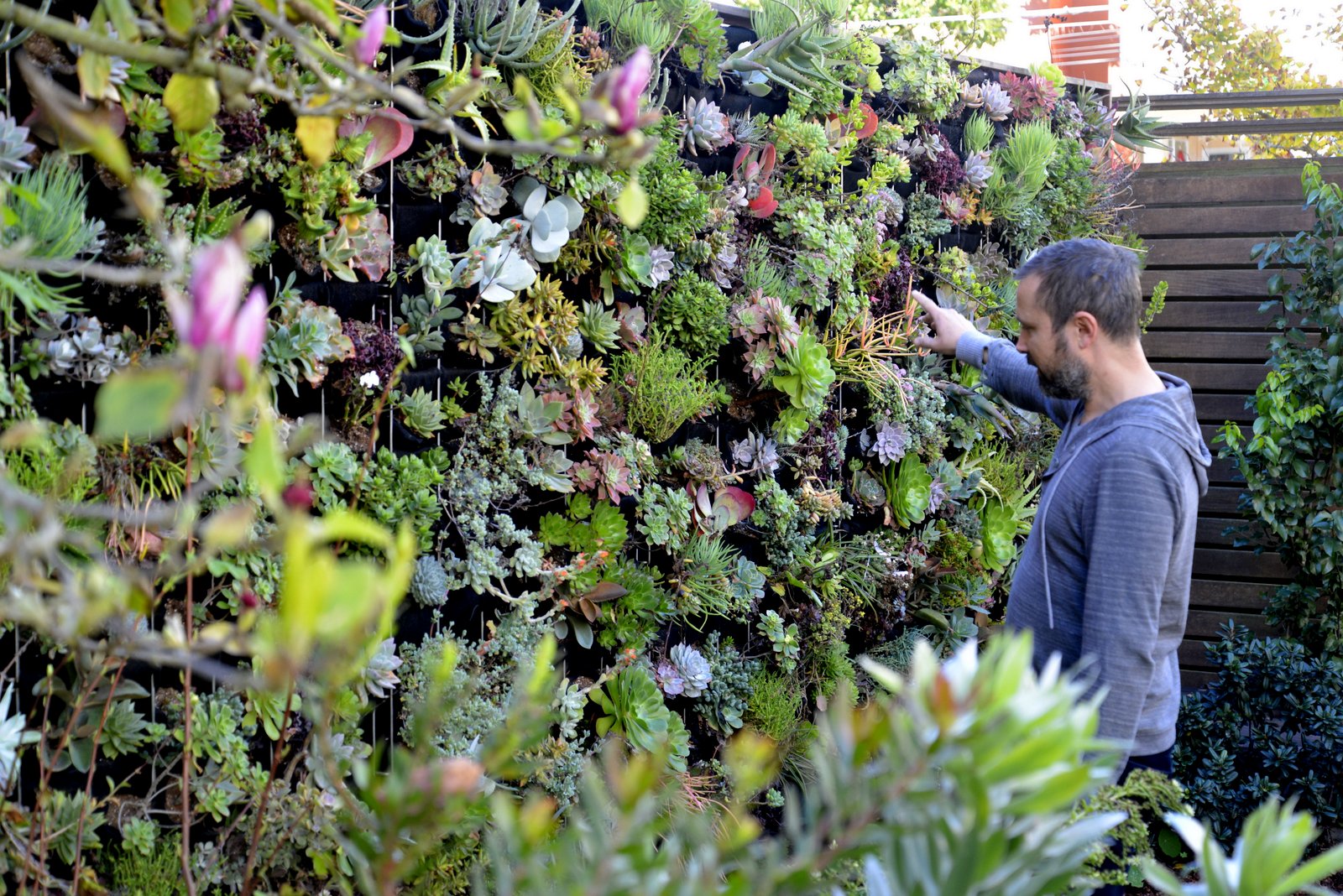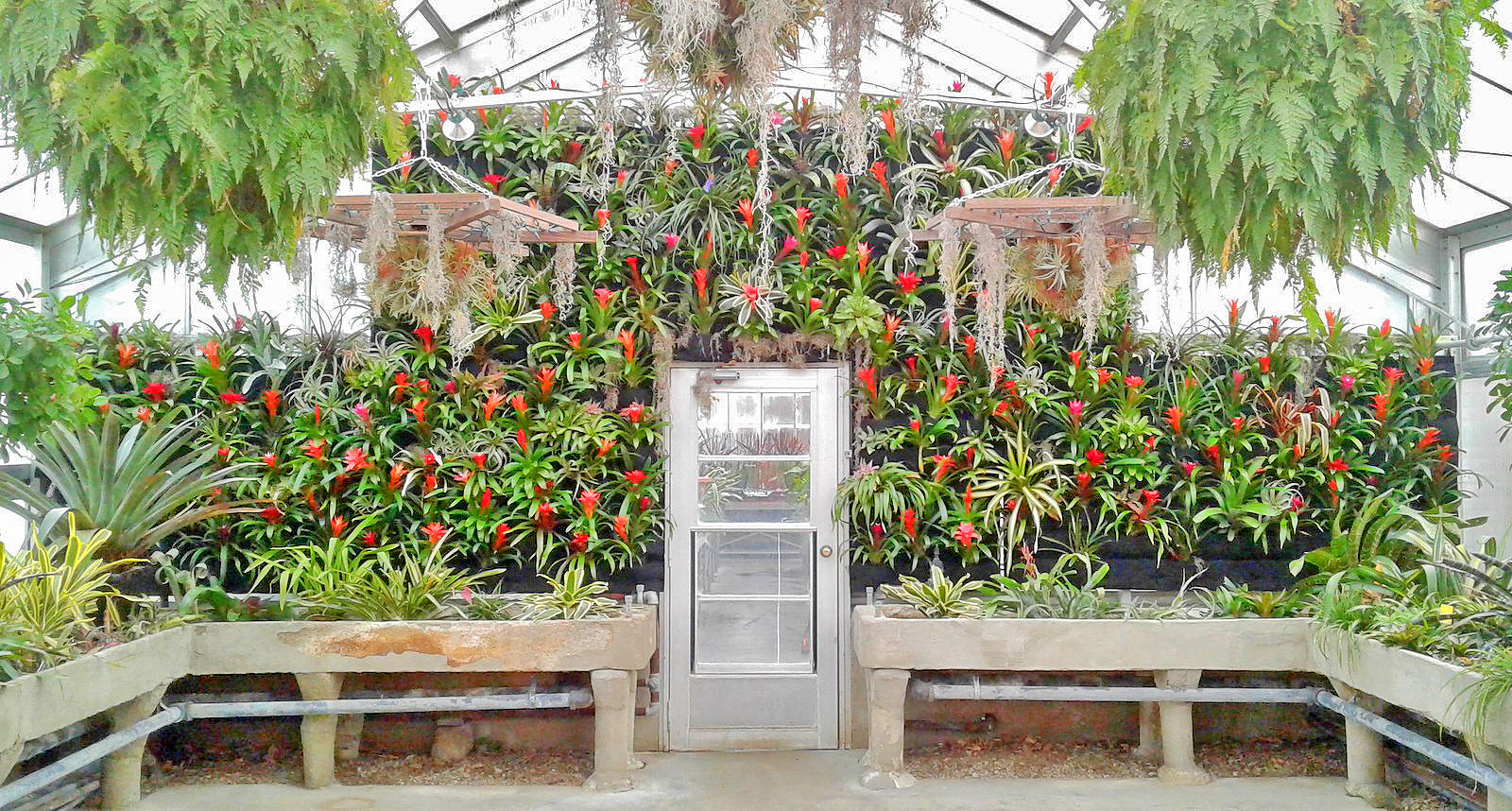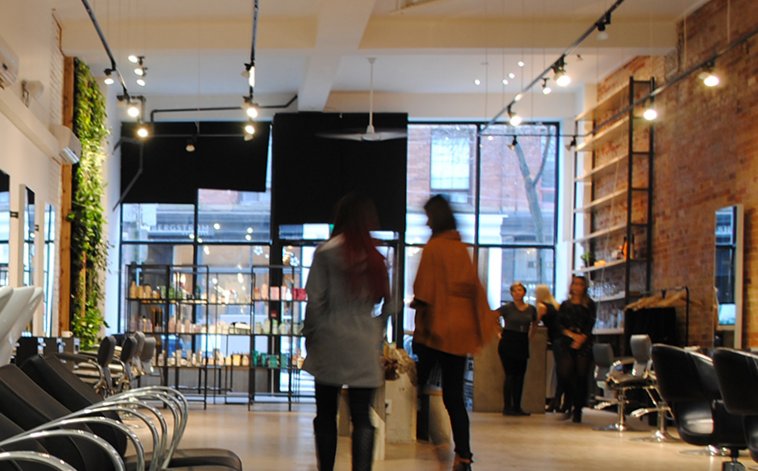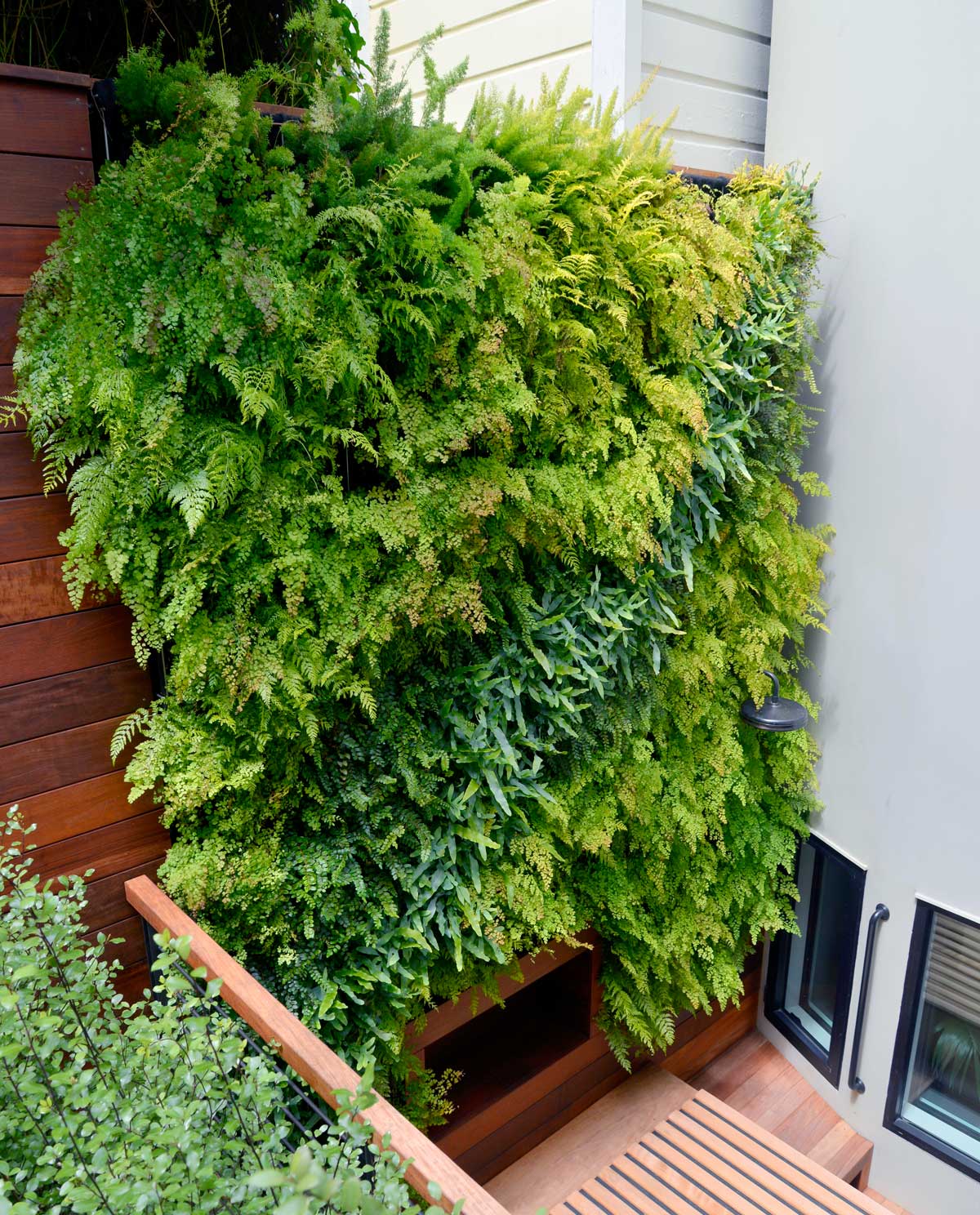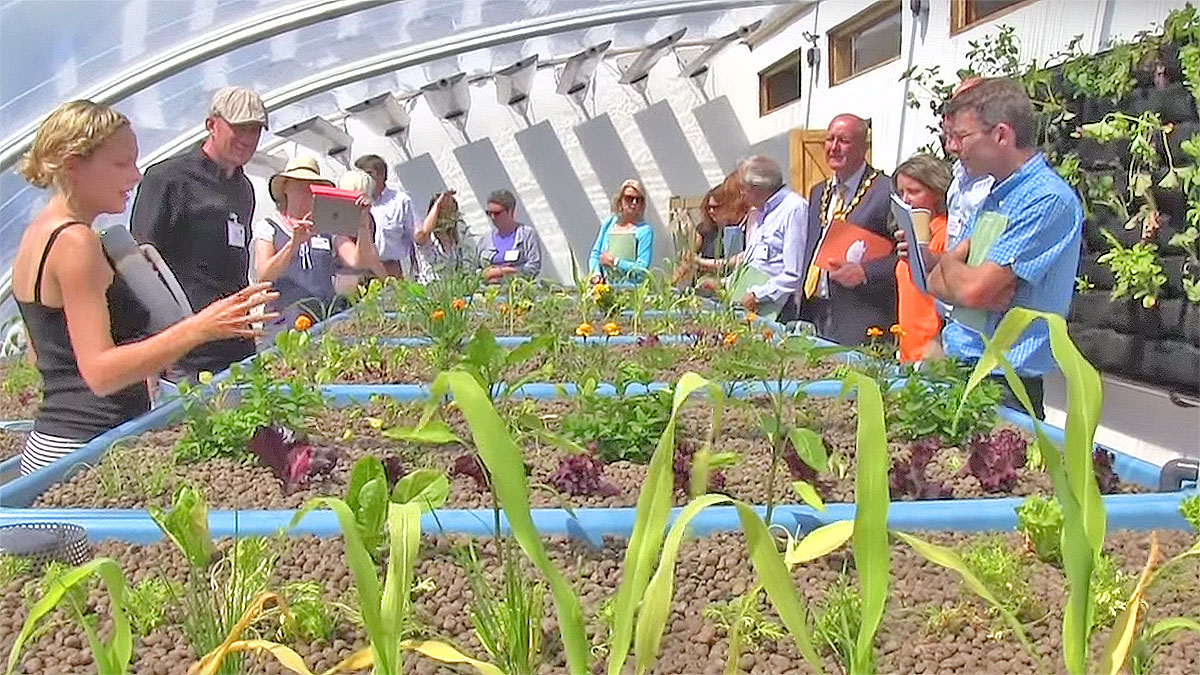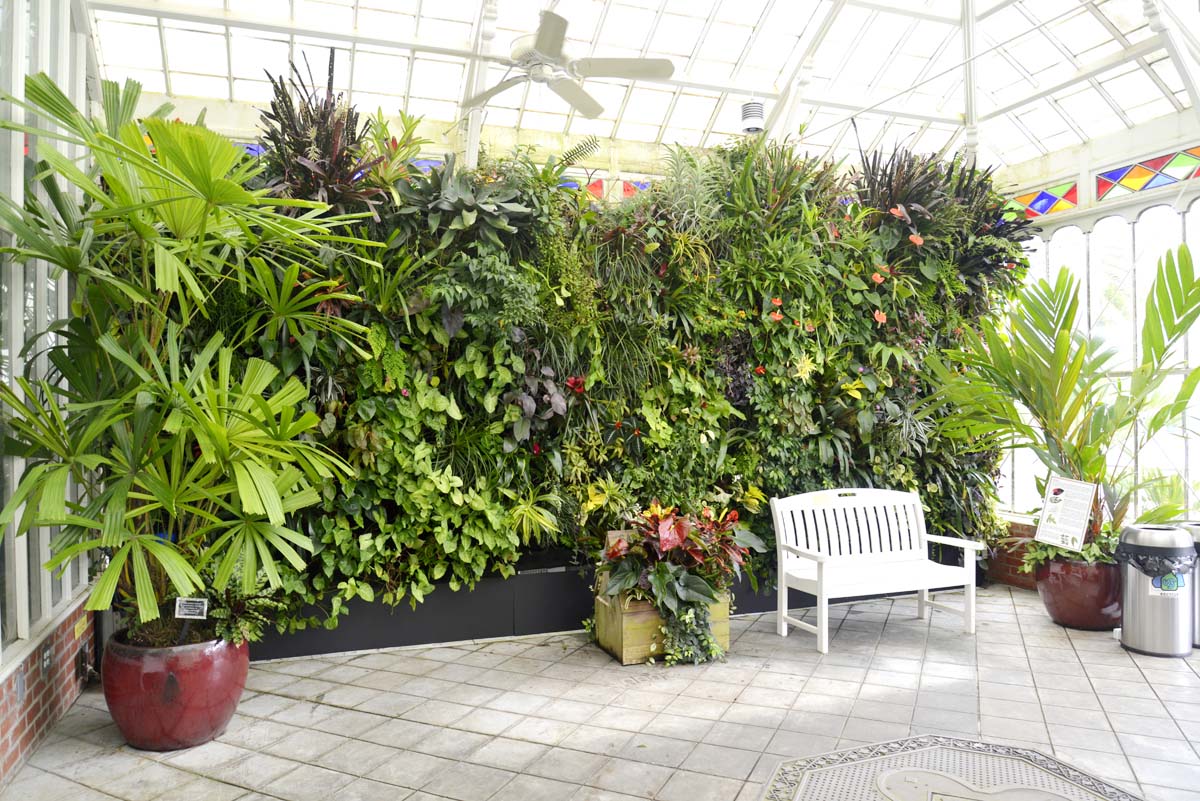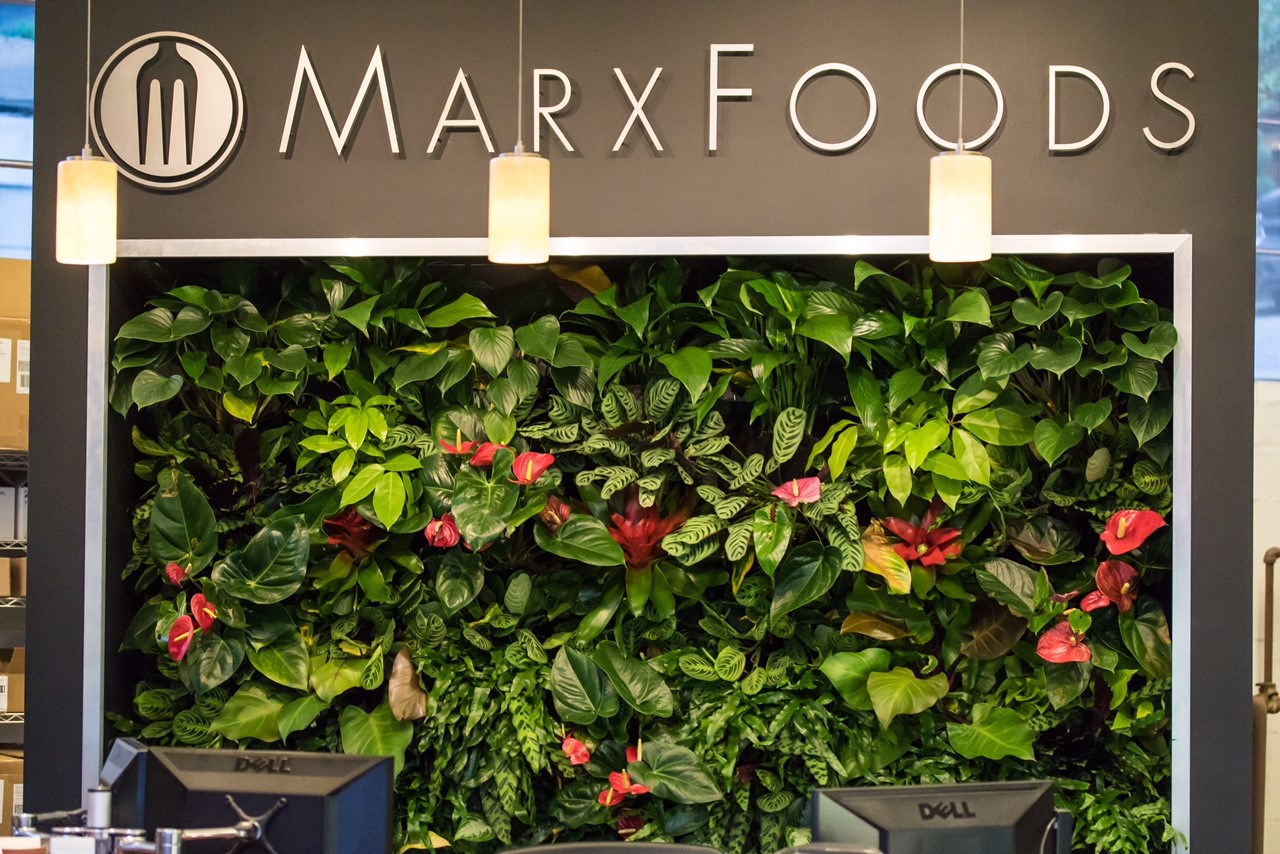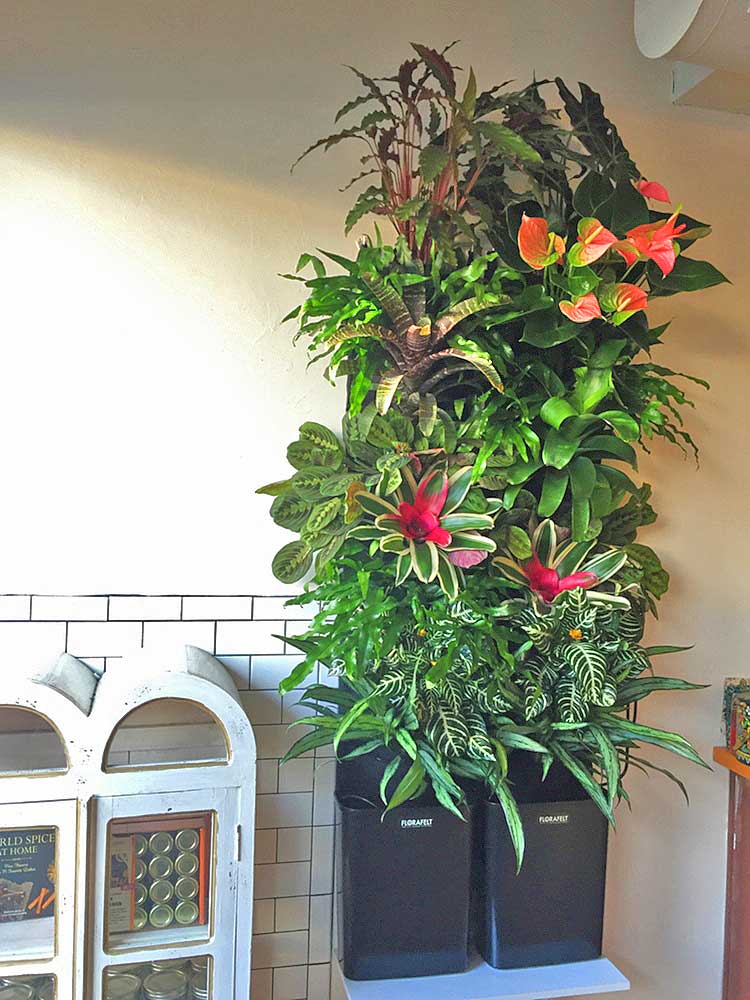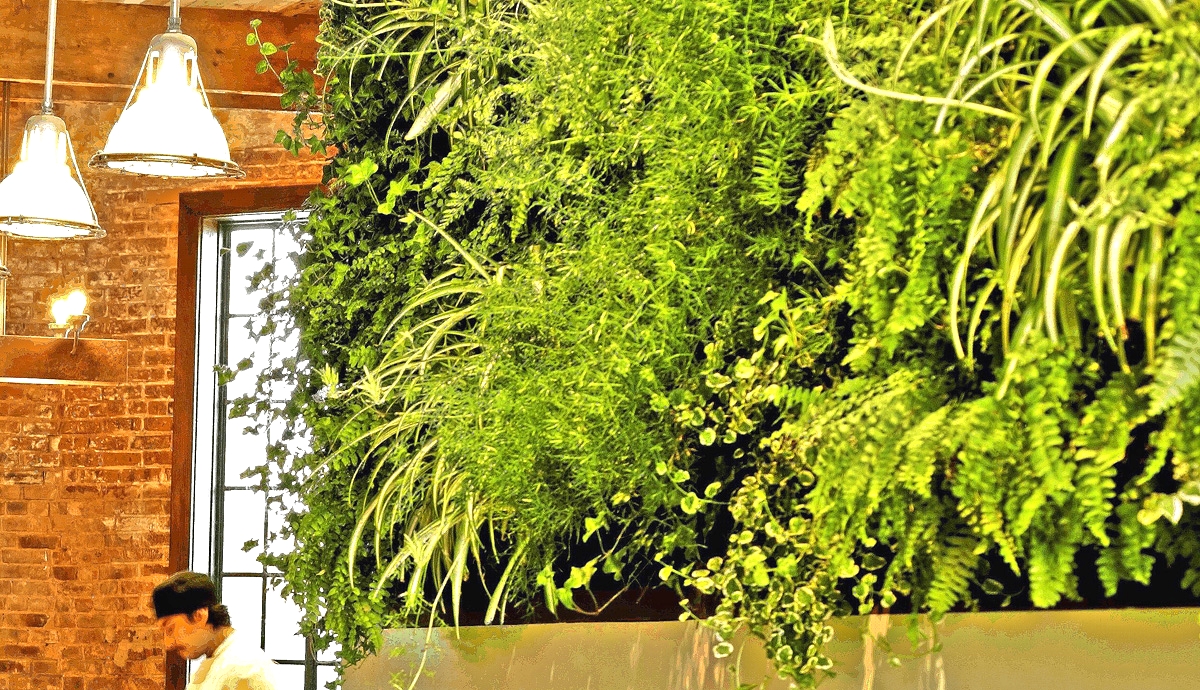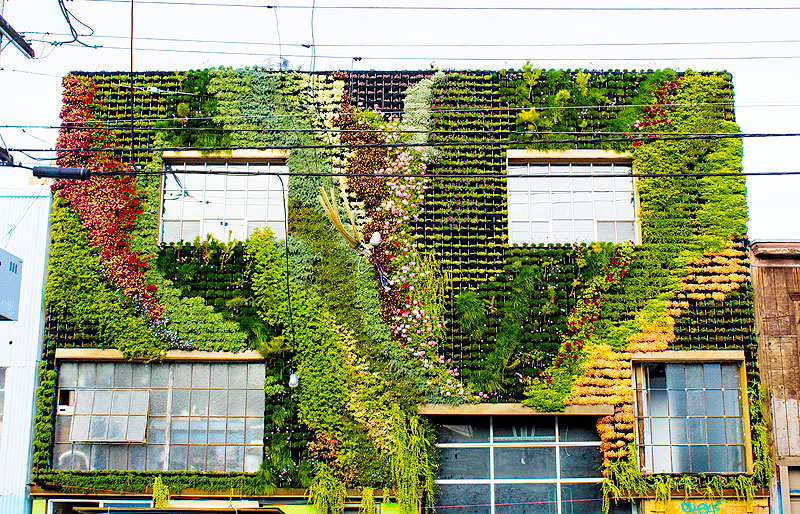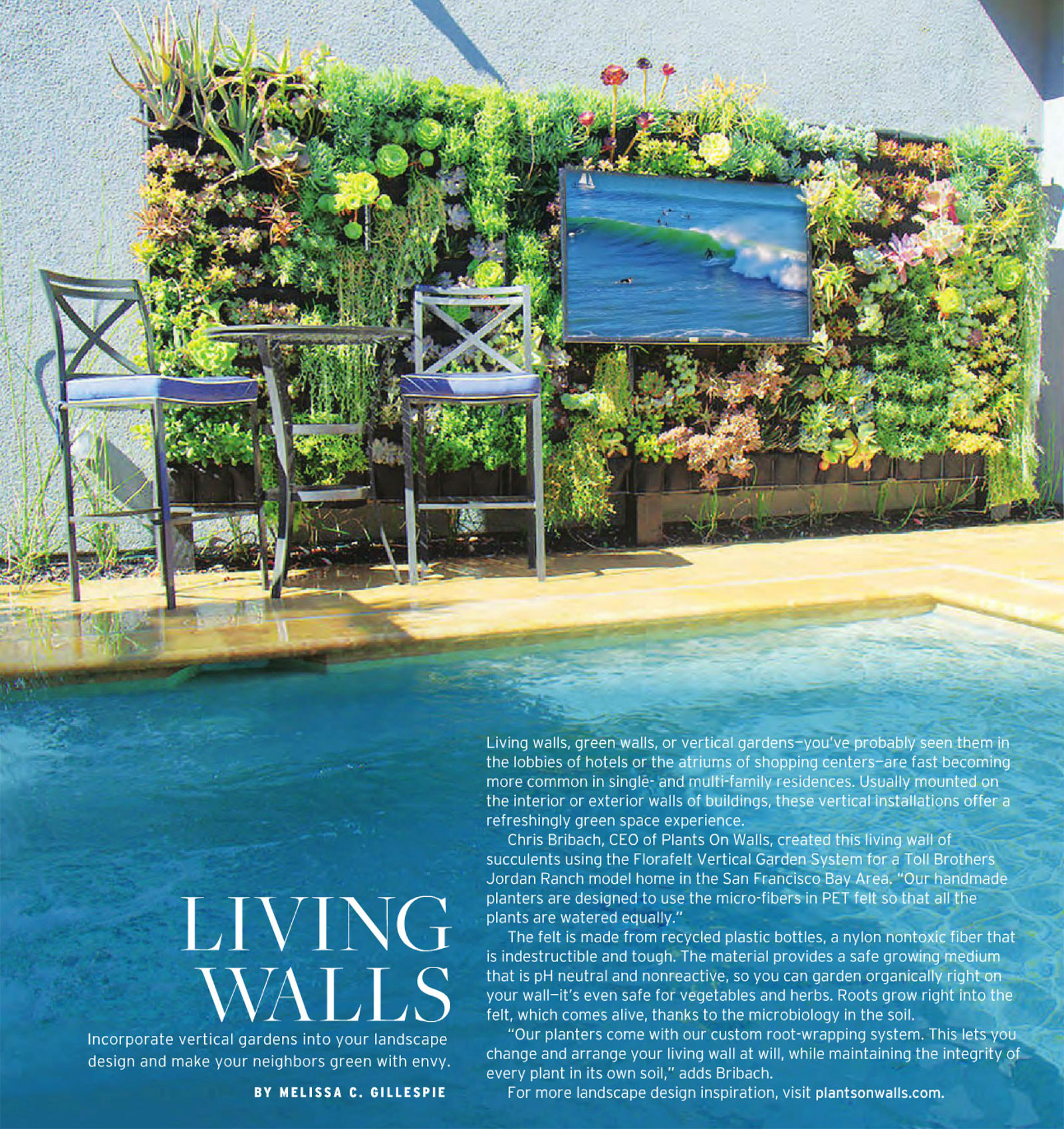Living Canvas Vertical Garden
Landscape architect Alec Hawley explores a dynamic collection of succulents for his own backyard living wall using the Florafelt Pro Vertical Garden System.
Alec experimented with a wide variety of succulent species to identify the most successful for the environment.
A wide variety of species are artfully mixed together create delightful experience.
The succulent garden is the focal point of the yard and provides a backdrop to the children's play area. It's an inspiring place to discover and learn.
A year after planting, nearly all have thrived and a sweeping expanse of color and texture creates a dynamic and exciting landscape element.
DESIGNER INTERVIEW Alec Hawley
Landscape architect Alec Hawley explores a dynamic collection of succulents for his own backyard living wall using the Florafelt Vertical Garden System.
Alec Hawley
Landscape Architect
San Francisco
Linkedin
Bromeliad Wall Vertical Garden
Laura Mast of Kingwood Center Gardens adds an exciting new addition to their showcase greenhouse. Florafelt Vertical Garden Planters are hung from a metal unistrut frame and filled with a colorful combination of root-wrapped bromeliads. The historic house and gardens are located in Mansfield, Ohio.
Urban Green Luxury Remodel
Luxury remodel in San Francisco's Cole Valley gets a big dose of urban green. Florafelt Living Wall System are used to fill the 30 foot tall window well with ferns. Joanna Wong and Durkin Inc. created a living wall as a focal point for their luxury remodel located in San Francisco's Haight Ashbury area.
Real Estate Developer Joanna Wong describes her experience using the Florafelt Vertical Garden System to design and construct a 3 story plant wall to create verdant views where once there were walls.
Phils and Ferns Vertical Garden
Designer Chris Bribach, Plants On Walls designed and installed a custom recirculating living wall for his client in San Francisco's Glen Park home using Florafelt Vertical Garden Planters.
Chris Bribach, designer and
Inventor of the Florafelt Living Wall System
Plants On Walls, San Francisco
chris@plantsonwalls.com
415-658-5498
Toronto Style Vertical Gardens
Designer Hande Ersoy created two living walls for "Untitled by Flaunt Boutique” in Toronto with Florafelt Vertical Garden Planters.
Hande Ersoy, Designer
Toronto, Canada
Phone: 1 (416) 276 0624
Email: hello@thatshande.com
Site: thatshande.com
Instagram: @thatshande
Wisdom and Age Grow Vertically
Landscape designer Davis Dalbok boasts his masterful aging vertical garden works on display at Living Green Design showroom gardens in San Francisco.
The entitled 'Birds of Prey' vertical gardens were transferred here after the 2013 Decorators Showcase in Pacific Heights. The Florafelt Pro System infrastructure was reconfigured into a large single living wall.
Blue Star Ferns and Leather ferns fill the lower areas that have more moisture while the Japanese Maples go dormant and lose their leaves for winter.
Leather Ferns mingle near the moist lower areas of the living wall. Woody stems of Conifers from the original installation begin to thicken with age. Grasses finish out their season with an undergrowth of dieback.
Living Green Design
Davis Dalbok
livinggreendesign.com
Luxurious Urban Oasis Fern Walls
San Francisco's foggy Fillmore district is ideal for grottos of lush ferns that enhance a spa and shower hidden within the plant wall. A total of 2000 plants are growing in three massive living walls throughout the home, the tallest of which towers 25 feet. They transform this luxurious urban home into a natural oasis.
Rock and Rose worked with landscape architect Tim O'Shea to design these massive vertical gardens. They used the Florafelt Pro System with direction by Chris Bribach of Plants On Walls, system installation by Mike Long of Longevity Construction, and final planting by Michael Bonicci of Showplant Nurseries.
Tim O'Shea chose a collection of practical yet lush ferns for the cavernous, low-light conditions including Mother, Maidenhair, Bird Nest, and Blue Star ferns. Babytears and Soleirolii provide a variety of textures and colors that grow into a smooth delicate carpet with a subtle wave of contrast from the yellow flowers of Maroon Oxalis.
The gardens are maintained monthly by the team at Showplant Nurseries who use tall ladders to keep the living walls manicured to perfection.
Humble by Nature Aquaponic Vertical Garden
A cute little cafe in England's Wye Valley uses vertical gardens and aquaponics to deliver fresh organic vegetables and greens for its customers.
This sustainable food experiment is called Humble by Nature after its founder Kate Humble who works with talented gardeners willing to take on this visionary challenge.
Fish tanks provide fertilized water for all the plants in the greenhouse.
A vertical garden component is featured within the greenhouse to create additional growing space.
Alongside the flooded growing beds, Florafelt Pocket Living Wall System adorns the Northern wall where tomatoes and other vegetables provide year-round food.
The cafe serves delicious meals made mostly from food produced from the greenhouse and nearby farms.
The learning farm offers classes on home-grown agriculture and provides adorable overnight cabins.
Caretaking The Conservatory of Flowers Vertical Garden
by Steph Kantorski
A redesign of the vestibule in San Francisco’s historic Conservatory of Flowers has created a breathtaking introduction for visitors to this world-famous Victorian structure. One of the largest and most beautiful vertical green walls in the city is now on full display for visitors inside North America’s oldest public wood-and-glass greenhouse.
San Francisco Conservatory of Flowers. Florafelt Vertical Garden System
This dramatic 360-pocket wall (created with 30 Florafelt 12-pocket panels) reflects the spirit of the Conservatory. It was created with donated materials and labor by people with an enthusiastic love for plants. The result is an exquisite display of tropical greenery, flowering varieties and colorful vines for a luscious eye-catching wall that stirs the imagination.
Davis Dalbok, Living Green Design. Decorator Showcase 2012. Florafelt Vertical Garden System.
It all began with the 2012 San Francisco Decorator Showcase that featured an exterior green wall designed by Davis Dalbok of Living Green Design and member of the Conservatory’s Advisory Council. The planted entry wall was made using the Florafelt vertical garden system invented by Chris Bribach of Plants On Walls.
Chris Bribach demonstrates how to create a simple succulent Florafelt vertical garden at the Conservatory of Flowers.
Jane Scurich (above right), Director of Development at the Conservatory of Flowers, remembers the Decorator Showcase wall as “breathtaking.” After the event, she asked Davis about acquiring a section of the display. Davis replied, “You don’t want a postage stamp, Jane, you want it to be the whole wall.” Davis contacted Chris about the project, who donated a custom-designed system to one of San Francisco’s most prestigious and beloved institutions. It was installed behind the greeter desk with special requirements to preserve the integrity of the elegant Victorian structure.
Florafelt Vertical Garden Planters donated by Chris Bribach of Plants On Walls. Conservatory of Flowers, San Francisco.
Around that time, volunteer Conservatory greeter Marilyn Singer passed away and her family donated many of the first plants in her memory. Later San Francisco Foliage donated more greenery. Senior Nursery Specialist Guadalupe Cota culled prime specimens from her greenhouse. As the number and variety of plants grew, it became clear that a stunning attraction was being created.
Guadalupe Cota, Senior Nursery Specialist. Conservatory of Flowers, San Francisco.
A dripline water and nutrient-delivery system also donated by Plants On Walls kept it lush and beautiful. Not long after, Guadalupe left the Conservatory and Nursery Specialist Mario Vega maintained it for the next few months. That’s about where I came in.
San Francisco Conservatory of Flowers. Florafelt Vertical Garden System.
Originally volunteering as a docent, I switched to the horticulture side in 2013 out of sheer fascination with the plants themselves. I was beyond thrilled when Mario put me on “vertical garden duty.” The last three years have been an invaluable education in what tropical flora do when prepared in Root Wraps, or the recycled PET “diapers” (as I affectionately call them), and stuffed inside pockets to grow vertically.
Pineapple plant and vanilla orchid. Conservatory of Flowers. Florafelt Vertical Garden System.
As I worked with the vertical garden, I found that plants were so happy they began to take over. The vanilla orchid vine grew with such force it pushed its neighbors up out of their pockets. The bromeliads flowered furiously and the philodendrons’ roots clamped on so ferociously I had to cut out entire pockets. Gesneriads, lipstick vines and exotic grasses spilled over and fought for light.
When the wall garden was finally tamed, I added more specimens to vary the color and texture. Now there’s a habanero pepper plant and two carnivorous Nepenthes, which I keep neatly trimmed because they tend to take over.
Hibbity Dibbity band’s photo shoot in July 2016 at the Conservatory of Flowers, San Francisco. Florafelt Vertical Garden.
Horticulturist Steph Kantorski describes her experience using the Florafelt System for the San Francisco Conservatory of Flowers vertical garden.
Conservatory of Flowers Garden Director Matthew Stephens
In early 2016, the Conservatory welcomed its new Director Matthew Stephens. Among his other exciting plans, the greeter desk was moved to the other side of the entryway allowing everyone to experience the living wall up close. The larger foliage at the top has been trimmed to reveal the building’s beautiful original stained glass. With the wall now on full display, this unique and astounding vertical jungle finally feels complete.
For a small entry fee you can visit the Conservatory of Flowers and take a free tour or stroll around on your own. You can also just step into the vestibule without a ticket to experience the living wall for yourself.
VIDEO: Chris Bribach of Plants On Walls installs a Florafelt Vertical Garden at the Conservatory of Flowers. September 2012.
Urban Renewal Grows in Cleveland
Architect Marika Shioiri-Clark revitalizes a neighborhood by working with the community to construct Cleveland's largest living wall using the Florafelt System.
Watch extended interviews with the architect and neighbors.
Florafelt Vertical Garden Planters were mounted to horizontal lumber supports bolted to the brick facade.
Architect Marika Shioiri-Clark. Hingetown Cleveland Living Wall. Florafelt Vertical Garden System.
Architect Marika Shioiri-Clark and a group of dedicated community volunteers bring the head-turning beauty of living walls to Cleveland's up-and-coming Hingetown district.
A wide variety of sedums and hearty grasses will grow into a seamless cliffside of cascading foliage.
Reclaimed water from rooftop rain runoff will irrigate the vertical garden for an exciting, eye-catching and ecological icon in an area flourishing from urban renewal.
Green Marketing Gone Vertical
Rebecca Sheedy of Floraform Design is thrilled that her first living wall is also one of her most visible. Marx Foods may be the first, but Rebecca has since spent five years creating living walls, and ran a business maintaining gardens for several years before that. “I just love plants and always find a way to be out there with them,” she says.
Marks Foods reception desk living wall by by Rebecca Sheedy, Floraform Design Seattle, framed Florafelt Compact Kits.
She honed her expertise while studying botany at the University of Washington and The Evergreen State College. “I’m really into color, contrast, texture and shapes,” she says. In fact, her expertise is international. “During college, I did research in Costa Rica to estimate the biomass of forest canopy. We found there’s more biomass in the canopy than on the forest floor.”
Marks Foods reception desk living wall by Rebecca Sheedy, Floraform Design Seattle, framed Florafelt Compact Kits.
Rebecca's first living wall serenely packs a green marketing punch from its post overlooking the Marx Foods checkout area. “I started small with a Florafelt Compact Living Wall Kit with 8-pockets for the first 6 to 8 months,” Rebecca explains. “I learned what plants were happy where. Now there are 7 Compact Kits lined up together for 56 pockets.”
Plus a gorgeous frame that beautifully sets off the plants within. “The frame was Marx Foods’ idea. To hide the freezers, we incorporated the garden into the freezer wall. The garden sets Marx apart, makes a statement and generates a lot of buzz.”
Rebecca Sheedy of Floraform Seattle uses two Florafelt Living Walls to create a larger install.
Rebecca selects plants as carefully as Marx Foods shops for their clientele. The garden includes Homalomena, Medusa Bromeliads, Kangaroo Paw Fern, Vresia (a mottled leaf bromeliad), Spathiphyllum, Anthurium, Aglaonema (has a good sprawling habit and fills in the edges"), Philodendron and Schefflera 'Soliel,' which has stunning chartreuse leaves.
Green healing: A Seattle doctor's examination room living wall by Rebecca Sheedy, Floraform Design Seattle, wall mounted Florafelt Compact Living Wall Kits.
Rebecca shopped around before settling exclusively on Florafelt Products. “Back then a lot of people created walls themselves in a Patrick Blanc style, stapling felt to a wall. But I made sure to use a Compact Kit – it’s fully contained and operates on its own. I like how the hardware is invisible. People saw it and got in touch with me.”
Since then, Rebecca has created distinctive and beautiful vertical gardens for restaurants, homes, wine shops, doctors’ offices, you name it. Interestingly, doctors request the gardens for their examination rooms. “There is a big alternative medicine scene here – doctors prescribe plants as medicine,” she says.
Inspired by design, Rebecca in Paris in front of a famous Patric Blanc living wall.
Rebecca Sheedy
Floraform Design
floraformdesign.com
Intern Builds Vertical Garden, Inspires Green Living
Angelica Rocha inherited her grandfather's green thumb to build her first green wall, complete with 50 fish! The minnows form a vital link in her new aquaponics vertical garden at the EcoCenter on San Francisco Bay. This Berkeley student is on a fast track to make the world a lot more green, so meet her now and say you knew her when.
Just completed in December at the EcoCenter at Heron’s Head Park, the 84-pocket living wall is Angelica’s internship triumph. “Kids love it!” she says. “I think the EcoCenter is happy to house such an amazing piece of living space.”
The nutrient-rich water from the fish tank feeds the plants, creating a closed cycle system that is a perfect example of sustainable urban living ─ what the EcoCenter is all about.
Eternally curious, Angelica had experimented at home with vertical gardens. Since she was so interested in them and horticulture, "The EcoCenter project spoke to me,” she says.
Perhaps also because her grandfather and uncles were agriculture and landscaping professionals in Mexico before coming to the U.S. She dove into learning about Plants On Walls and Florafelt, too. “I was amazed at the projects. Each one is absolutely beautiful. I was so impressed, I had to learn more.”
Angelica arrived at the EcoCenter through a course, Applied Research in Sustainability, at City College of San Francisco. She now studies environmental management at UC Berkeley, after earning her bachelor’s degree last year in recreation, parks and tourism administration at San Francisco State University.
An amazing community and education center, the EcoCenter brings sustainable power, water and wastewater systems to life. It’s the first LEED Platinum - Zero Net Energy Building in San Francisco. Here you’ll discover a living roof, rainwater harvesting, constructed wetlands and much more.
Angelica helped run the popular Science Saturday programs that foster public interaction, and gave tours that required deep knowledge of San Francisco's watershed, Eco Center's wastewater treatment, biomimicry, environmental design and local wildlife.
For the aquaponics living wall, Angelica worked with Florafelt CEO Chris Bribach, who advised her at each step. Kids and adults alike had fun root-wrapping the native plants.
Assembly of the Aquaponic Vertical Garden
If you've ever built an Ikea bookcase, the idea is the same: all parts are labeled and ready to assemble.
The patented Grow Bun allows water to reach every plant, wicking moisture into the felt where the roots grow while keeping the front dry and drip-free.
“I believe vertical gardens are the best solution for greening the urban environment. They require little space and make a big impact inside and outside,” she says. “They benefit the environment and ourselves ─ improving air quality, reducing particulate level, reducing stress, increasing productivity, and more.
“The EcoCenter is right on the waterfront of San Francisco Bay, one of the most invaded watersheds in the world. I wanted to bring in marsh plants, similar to ones you'd see outside, as a talking point for how our watersheds filter themselves.”
What’s next for this intrepid intern? Big goals, of course: making her mark in green infrastructure and environmental planning, and adding more vertical gardens to the world. She also plans to complete a 20-day hike along the John Muir Trail from Yosemite to Mount Whitney.
Bouncing Back In Brooklyn
Grateful for the spent fury of Jonas, our thoughts turn to that other superstorm, Sandy – and recall a vertical garden so tough, a historic hurricane couldn’t bring it down. In fact, for renowned New York restauranteurs Laurent Kalkotour and Leslie Affre, and acclaimed landscape designer FireDean Schilling, the logical thing was to build two more.
The big reveal. FireDean Schilling, The Brooklyn Garden Club, Atrium DUMBO. Florafelt vertical garden.
October 29, 2012: what is now Atrium DUMBO had been open just six months, following a year of pressure and preparation. The restaurant lies just a few feet from a waterside park in the eclectic and happening DUMBO (Down Under the Manhattan Bridge Overpass) neighborhood in Brooklyn.
For the opening, FireDean designed and installed a gorgeous 16x5-foot living wall made with Florafelt. “Vertical gardens are ideal for hotels and restaurants because you need a memorable experience,” he says. “There is an undeniable energy that resonates – maybe it’s the higher level of oxygen!”
A dark moment.
When Sandy hit, more than five feet of seawater barreled through the back door. Just about everything was demolished. The owners rang up one of their line cooks and then all went to the restaurant during the hurricane, but all measures to protect it were in vain. Closed for months, no federal assistance was provided to rebuild.
Surviving Hurricane Sandy. Atrium DUMBO vertical garden, FireDean Schilling, The Brooklyn Garden Club.
Ridiculously resilient.
About the only thing that survived was FireDean’s green wall. “It was kind of an inspiration. It looked pretty good, but with a completely destroyed restaurant around it,” he says. The owners brought him back, thinking it also needed replacing, but FireDean said not necessarily.
Leslie Affre, FireDean Schilling and Chef Laurent Kalkotour. The Brooklyn Garden Club, Atrium DUMBO.
“We took out most of the plants, cleaned them up, replaced them and fixed the irrigation system. We also kept the structure.” In addition, FireDean donated toward the rebuild, helped with the cleanup and promoted fundraising efforts.
To date, FireDean has created a second wall and is busy designing a third for Leslie and Chef Laurent’s newest restaurant as well. “Green walls make complete sense with their impact and beauty. They’re practical and they work. If you make it pretty, they will come.”
FireDean Shilling. Woodland Landscapes Brooklyn. Colonie Restaurant. Florafelt vertical garden.
With 20 years of experience, FireDean is an urban landscape guru, tackling tough spaces, rooftop gardens and living walls. He’s excited about the future, too. “There’s a huge cultural shift. Young people are growing up with this. Coupled with an architectural background, we have a generation of people who will incorporate this kind of design in urban planning,” he says. “Before building, planners and architects now ask: where will the plants go?”
Fire Dean Shilling. Woodland Landscapes Brooklyn. Darrow Street Restaurant. Florafelt vertical garden.
With New York City no stranger to sub-zero temps, FireDean takes care to help clients learn what works best in their climate. “I generally choose from a spectrum of plants that adapt to low light and feel like you’re walking in New York State. Look at the High Line (a public park built on an old rail line above the streets on Manhattan’s West Side). They chose scrub oaks and stuff that already grew there. We test growth habits, whether it’s a natural cascading effect or aggressive vine. And we emphasize maintenance to always look 100 percent.”
And hurricane-proof.
He built one, and here they come.
Seth Stottlemyer's first vertical garden is a stunner! Trained in Washington, DC, apprenticed in New York, and now headquartered in Sarasota, this entrepreneur brings a little northern exposure to the sunny South.
As a rising star landscaper, Seth is big on keeping up to date ─ not surprising since he managed energy efficiency programs at Con Edison, received professional certification from Green Roofs for Healthy Cities (headquartered in Toronto), and studied at the New York Botanical Garden. He apprenticed at the renowned Town and Gardens firm in New York City, rising to manage high profile residential and commercial sites.
So when this fan of living architecture saw the growth in vertical gardens, he built a 10x9-foot demo wall at his new business, Oasis Gardenscapes. He even added weathered driftwood for regional flavor and artistry.
One might think that in Florida, only tropical plants that soak up the sun all day survive – not so. “Our vertical garden is north facing and doesn’t get a lot of direct sun. In fact, there is a slight roof overhang,” says Seth. So he created a masterpiece including ferns, philodendrons, bromeliads and peperomia, which work well in lower light. Peperomia’s many varieties include silver and burgundy stems and leaves for added punch; that and its attractively mounted compact habit make it a great wall companion.
Needless to say, the living wall creates “A lot of buzz. I think this will take off big for me,” Seth says. One project gained as a result is a 9x11-foot wall for a new client’s dining terrace, which is surrounded by indirect light.
Seth grew up gardening and running the family business in Sarasota, but after years of work and education up north, he enjoys getting to know the southern plant palette again.
“Xeriscaping is taking off down here,” he says. “We’re using hardscaping like shells and rocks and drought resistant plants. There is a lot less maintenance: no need to cut, weed and fertilize all that grass.”
“We have a lot of courtyards where vertical gardens would be perfect,” he says. “I want to promote herb gardens and lettuces, which are popular here. With my experience in New York City, you have to bring your professional A game to high-end properties. I’m also excited to bring in my own artistry and flavor.”
Designing In Sync With Mother Nature
Holy bromeliad, Batman! Jeffrey Allis of Tru Vine Design creates spectacular living walls and adds real value for his clients just by looking around.
“I don’t sell just green walls −it’s an environment,” this South Florida designer and horticulturist says. Passionate about plants since age 13, he’s built much of his success by embracing the scientific principles of biomimicry. Put simply, biomimicry is an approach to finding sustainable solutions by imitating nature's own patterns and strategies. For instance, the design behind velcro actually mimics how burrs grab and hold on in nature!
Jeff sees biomimicry in action through his extensive travels through the U.S., Europe and Central and South America. It’s in these latter regions − Panama, Brazil, Nicaragua – where he finds inspiration for his Florida gardens. He observes how plants act in their natural environment and comes back with new and often surprising revelations.
“I never thought agaves would work, but I traveled to Nicaragua and saw agave sticking out of a wall. I saw it grown in nature,” he says. “The philodendron family likes to crawl up, over rock faces, so they’re a good choice. Bromeliads also do well."
“God’s got this down. Don’t be complicated, be observant.”
Jeff has built a distinguished name for himself as a trusted expert on which plants work together in a vertical garden and which don’t. Often his walls contain more than 1,000 specimens. “Lots of people build green walls that are meant to fail,” he says. “There are so many nuances: wind, sun, light, time of year. I’ve turned down projects that won’t work. Be honest. When I turn down business, I gain business.”
Jeff also calls himself a biophilic designer, biophilia meaning the instinctive bond between human beings and nature. “There’s evidence that our environment shapes our feelings and has a positive impact on us,” he says. “Plants make people feel happier, healthier. They have positive energy and affect our psychological well-being.”
With this in mind, Jeff works with each client to deliver an intensely personal experience. And that’s not all. “I want to take biophilic design to another level and get involved with a children’s hospice, creating gardens to help people heal,” he says.
Jeff thinks we’ve just begun to tap vertical gardening’s potential as a healing tool for ourselves and for the planet. “Right now, America designs green walls for decorating mostly,” he says. “In the future, green walls will be more recognized for their ability to cool spaces, bring the electric bill down, and use water wisely.”
Six Ways To Scrub Your Air
What’s better than the gift of clean air? Thanks to her unique skills in green building and regenerative design, Amanda Goldberg of Planted Design has the air quality thing down, so breathe easy. Learn more about her vertical gardens, also available for rent, and innovative ideas that combine beauty with healthier air, inside and out.
Amanda Goldberg of Planted Design works with Brandon Pruett of Living Green Design to transform an industrial building into a living facade.
Did you know? 70% of the detoxing our bodies need is supplied by breathing (perspiration provides 20%). And yet, dangerous volatile organic compounds released by carpets, copiers, and most any synthetic item in our lives rob us of clean air daily!
“People often don’t think about the VOC gases given off by fresh paint, flooring, carpet and cleaning products,” says Amanda. “More people in a room also raise carbon dioxide levels. Too much CO2 makes us sleepy and causes headaches, nausea and sickness.”
With all those hazardous compounds and carbon dioxide hanging around, Amanda creates living walls that work hard to remove ammonia, benzene, formaldehyde, and other toxins from the home and workplace. Thanks to photosynthesis, plants also replace toxins with vital oxygen
Amanda’s top plant picks for healthier indoor air
1. Pothos
2. Orchids
3. Philodendron
4. Snake plant
5. Spider plant
6. Peace lily
Amanda created her first vertical garden while working for Cradle to Cradle Products Innovation Institute, helping companies such as Aveda design products for a sustainable economy. Last March, she “took a leap” and started her own business bringing walls to life. She started with an 8x4-foot mobile vertical garden for the Natural Products Expo in Anaheim, CA, then installed it in her client's office in Palo Alto, CA.
Pothos Vertical Garden for Go Raw by Amanda Goldberg Planted Design.
Now her creativity knows no bounds. With her unique custom portable gardens, Amanda is tapping into, and ramping up, the market for living wall rentals – weddings, conferences, photo booths and more. Because these gardens need backlighting, company logos and other special touches, Amanda turns to a whole community of artisans to bring out the best in her projects. As a ceramic artist and industrial designer who created a “living desk” for her college thesis, perhaps it’s only natural. “I enjoy the collaborative spirit. It inspires and invigorates me," she says.
Partners in design: Amanda and Brandon Pruett from Living Green Design co-created this living wall in San Francisco’s Mission District, turning a sterile heat island into a thriving green oasis.
Florafelt Pro System filled with California Native Species by Amanda Goldberg and Brandon Pruett in San Francisco on 14th Street between Mission and Folsom.
Urban Renewal volunteer root-wrapping team led by Amanda Goldberg and Brandon Pruett.
Amanda says she’s happy with the ease and flexibility of Plants On Walls‘ Florafelt system. “You can put plants in, then exchange them for a different aesthetic as your style changes."
How much is enough? For a 1,800 square foot house, a NASA study recommends 15 to 18 good-sized plants that clean the air and give off oxygen.
Exploring Color and Contrast
Monet would be proud. Living Green Design is a noted San Francisco firm that, in their words, “takes a unique approach to garden design that crosses borders, styles and trends.” Their folks believe strongly that interior design, plantscapes and style should all connect to the exterior garden seamlessly. A vertical garden was an ideal way to incorporate this concept of unified indoor and outdoor living.
Davis Dalbok, founder and principal designer, and Brandon Pruett, who specializes in creating multi-dimensional vertical living walls, installed a large, 20x10-foot vertical garden at their San Francisco showroom.
They filled the Florafelt system with a vibrant textural feast of ferns, grasses, yellow oxalis and even trees − Japanese maple!
Oxalis is especially versatile when “painting” a vertical garden: besides yellow, the profuse flowers are available in pink, purple and white, and their foliage adds even more color and texture: chartreuse, purple, maroon, silver, purple-black, speckled combos and more.
Oxalis also thrives in part shade and likes well-drained, moist soil. Reliable up to zone 5, the plants can be treated as perennials in warmer climes; they’ll need overwintering inside if grown in climates like the Midwest, or they can be treated as annuals.
Davis says the garden is a hit. “When clients enter, they are so impressed by the diversity of plant material, and the sheer scale, that they almost always begin to figure out how they might incorporate something similar into their home or office. Most of the ambient natural light comes from skylights above, so this garden provides the perfect opportunity to ‘zone’ the placement of plants in the overall design, demonstrating how one can achieve a successful installation by addressing all of the particulars.”
Davis Dalbok, Brandon Pruett, Decorator Showcase 2013, Florafelt System
Plant materials for their showroom were repurposed from the 2013 Decorator Showcase in Pacific Heights San Francisco. Birds of prey was the title of this exhibition that featured grasses and conifers, maples and ferns.
All plants which are not typical to vertical gardening but were a total transformation of this enclosed space to a lush landscape of lore.
Davis Dalbok, Brandon Pruett, Decorator Showcase 2013, Florafelt System
The Living Green team continues to delight and amaze with their unique vision that delivers an experience to be remembered.
Aquaponic Vertical Vegetable Garden
Led by Kate Humble, Aquaponics UK are providing technical expertise to explore sustainable food growing techniques using aquaculture, farming fish, and hydroponics with few inputs and many, high value outputs.
Florafelt Wall Planters are employed to grow a variety of vegetables at a sustainable future farming concept greenhouse. The entire vertical garden system was supplied by Eden Green Walls for the Humble By Nature's Solar Aquaponic Greenhouse in Wye Valley, UK.
Stephen Schofield of Eden Green Walls. Humber By Nature. Solar Aquaponic Greenhouse, Florafelt System
Kate Humble and Aquaponics UK, Humble By Nature
Led by Kate Humble, Aquaponics UK are providing technical expertise to explore sustainable food growing techniques using aquaculture, farming fish, and hydroponics with few inputs and many, high value outputs. The goal is to recycle the nutrient rich water into soil-less vegetable production filtering the water in the process so it can be constantly reused.
This passive solar greenhouse is designed to house a productive, edible ecosystem which is also combined with a variety of other complementary farming techniques such as producing fish and poultry food from insects, growing mushrooms from used coffee grounds and growing poultry, fed from by-products of the system.
Stephen Schofield of Eden Green Walls. Humber By Nature. Solar Aquaponic Greenhouse, Florafelt System
Australian Grasses Vertical Garden
Fytogreen designers created a huggable vertical garden for the Glen Iris Cricket Club in Melbourne, Australia using Florafelt Vertical Garden Planters.
Featured on Green Roofs Australia this grassy masterpiece features native plants that could best survive the rugged conditions here while also looking smart with the modern architecture if flanks.
This small yet impressive vertical garden and living roof has a plant design incorporating native species only and extends the reserve parkland area onto the building. Both the roof garden and green wall are irrigated by rainfall collected from the building roof and stored in a nearby rainwater tank.
The vertical garden uses lush thick foliage for this pallet of plants making it resilient to a range of conditions while requiring minimal maintenance. Fytogreen’s botanist selected 10 different species and used 200 plants to cover the area of the northeast facing wall.
Poolside Theater Vertical Garden
Luxury Pools Magazine features a poolside theater vertical garden filled with succulents designed by Chris Bribach of Plants On Walls using the Florafelt Pro System for a Toll Brother's Jordan Ranch model home in Dublin, California.
Luxury Pools Magazine. Chris Bribach, Plants On Walls. Florafelt Pro Vertical Garden System.

